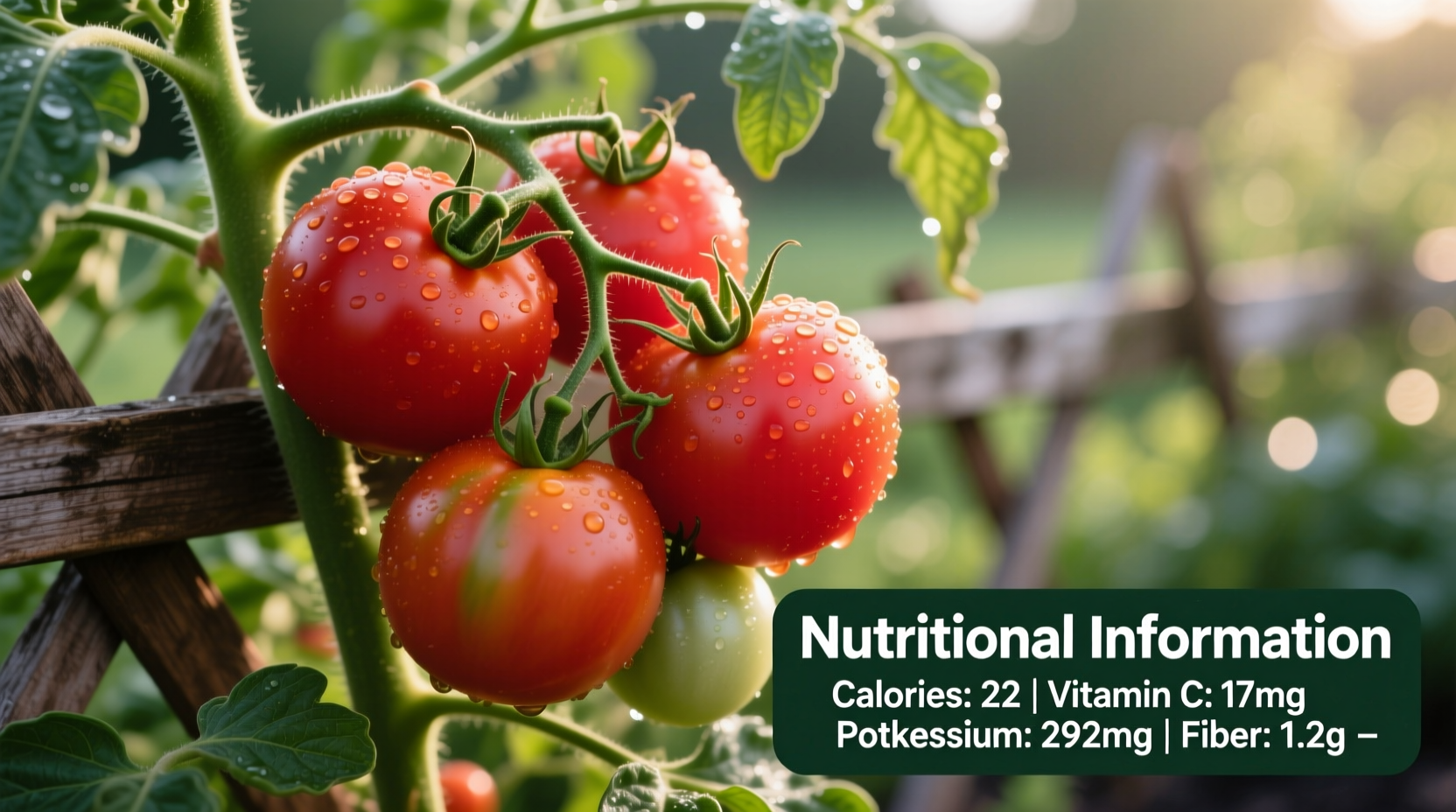Understanding the exact calorie content of tomatoes helps you make informed dietary choices without sacrificing flavor. Whether you're tracking macros, managing weight, or simply curious about nutrition, knowing these numbers empowers your food decisions.
Exact Calorie Counts by Tomato Type and Size
Tomatoes vary in calorie content based on variety, size, and preparation method. The USDA FoodData Central provides the most authoritative nutrition information for fresh produce. Here's a detailed breakdown of calorie counts for common tomato varieties:
| Tomato Type | Standard Serving Size | Calories | Carbohydrates | Water Content |
|---|---|---|---|---|
| Medium raw tomato | 148g (about 2" diameter) | 22 | 4.8g | 95% |
| Cherry tomatoes | 100g (about 10-12 pieces) | 18 | 3.9g | 94% |
| Roma tomatoes | 100g | 21 | 4.6g | 94% |
| Beefsteak tomatoes | 100g | 17 | 3.9g | 95% |
| Sun-dried tomatoes | 28g (1 ounce) | 76 | 16g | 15% |
| Tomato juice | 248g (8 fl oz) | 41 | 8.9g | 94% |
Source: USDA FoodData Central, Release 17 (2024)
Why Tomato Calorie Counts Vary
Several factors influence the calorie content of tomatoes:
- Water content - Tomatoes are 94-95% water, which explains their low calorie density. Larger varieties like beefsteak tomatoes have slightly higher water content than smaller cherry tomatoes.
- Ripeness - As tomatoes ripen, their sugar content increases slightly, raising calories by about 5-10% from green to fully ripe.
- Preparation method - Cooking concentrates flavors and reduces water content, increasing calories per gram. Sun-dried tomatoes contain significantly more calories due to water removal.
- Growing conditions - Soil quality, sunlight exposure, and watering practices can cause minor variations in sugar content.

Tomatoes in Your Daily Nutrition Plan
Tomatoes contribute more than just low calories to your diet. They're packed with essential nutrients that support overall health:
- Vitamin C - One medium tomato provides 28% of your daily vitamin C needs
- Lycopene - This powerful antioxidant gives tomatoes their red color and offers significant health benefits, especially when tomatoes are cooked
- Potassium - Important for heart health and blood pressure regulation
- Fiber - With 1.5g per medium tomato, they help with digestion and satiety
For weight management, tomatoes are an excellent choice. Their high water and fiber content create volume with minimal calories, helping you feel full while staying within your calorie goals. Adding tomatoes to salads, sandwiches, or as a snack can enhance meal satisfaction without significant calorie impact.
Practical Applications for Meal Planning
Understanding tomato calories helps you make smarter choices in various eating scenarios:
- Salad building - A cup of cherry tomatoes (150g) adds just 27 calories to your salad while providing volume and flavor
- Snacking - Two medium tomatoes make a satisfying 44-calorie snack rich in vitamins
- Sauce preparation - Three cups of fresh tomato sauce (about 600g) contains approximately 132 calories before adding other ingredients
- Meal replacement - Substituting higher-calorie ingredients with tomatoes can reduce overall meal calories by 100-200 without sacrificing satisfaction
Common Misconceptions About Tomato Calories
Several myths persist about tomato nutrition that deserve clarification:
- "All tomatoes have the same calorie count" - As shown in our table, different varieties have slightly different nutritional profiles based on size and water content.
- "Cooked tomatoes have more calories than raw" - While cooking concentrates nutrients per gram, the total calories in a whole tomato remain the same. The difference comes from reduced water content.
- "Tomato products are just as low-calorie as fresh tomatoes" - Processed tomato products like ketchup, sauces, and sun-dried tomatoes often contain added sugars or have water removed, significantly increasing calories per serving.
When tracking calories, always consider whether you're using fresh, canned, or processed tomato products, as their nutritional profiles differ substantially. For the lowest calorie option, choose fresh tomatoes over processed alternatives.
Maximizing Tomato Nutrition in Your Diet
To get the most nutritional value from tomatoes while managing calories:
- Eat tomatoes with a small amount of healthy fat (like olive oil) to increase lycopene absorption by up to 4x
- Choose vine-ripened tomatoes when possible for higher nutrient density
- Include both raw and cooked tomatoes in your diet for different nutritional benefits
- When making sauces, minimize added sugars and oils to maintain the low-calorie advantage
- Use tomatoes as a base for low-calorie soups and stews to add flavor and volume
Remember that tomatoes are naturally low in calories but high in flavor and nutrients, making them an ideal component of balanced eating patterns like Mediterranean, DASH, or weight management diets.











 浙公网安备
33010002000092号
浙公网安备
33010002000092号 浙B2-20120091-4
浙B2-20120091-4